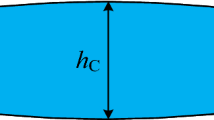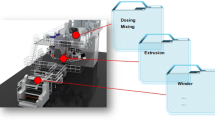Abstract
Data-rich environments in modern rolling processes provide a great opportunity for more effective process control and more total quality improvement. Flatness is a key geometrical feature of strip products in a cold rolling process. In order to achieve good flatness, it is necessary to reveal the factors that often influence the flatness quality, to develop a general flatness pattern prediction model that can handle the varying operating condition during the rolling of products with different specifications and to realize an effective flatness feedback control strategy. This paper develops a practical data mining-based flatness pattern prediction method for cold rolling process with varying operating condition. Firstly, the high-dimensional process measurements are projected onto a low-dimensional space (i.e., the latent variable space) using locality preserving projection method; at the same time, the Legendre orthogonal polynomials are used to extract the basic flatness patterns by projecting the high-dimensional flatness measurements into several flatness characteristic coefficients. Secondly, a mixture probabilistic linear regression model is adopted to describe the relationships between the latent variables and the flatness characteristic coefficients. Case study is conducted on a real steel rolling process. Results show that the developed method has not only the satisfactory prediction performance, but good potentials to improve process understanding and strip flatness quality.


















Similar content being viewed by others
References
Abdelkhalek S, Montmitonnet P, Legrand N et al (2011) Coupled approach for flatness prediction in cold rolling of thin strip. Int J Mech Sci 53(9):661–675
Belkin M, Niyogi P (2001) Laplacian eigenmaps and spectral techniques for embedding and clustering. Adv Neural inf Process Syst 14:585–591
Calinon S (2009) Robot programming by demonstration: a probabilistic approach. EPFL/CRC Press, Boca Raton
Carr K, Ferreira P (1995) Verification of form tolerances, part I: basic issues, flatness, and straightness. Precis. Eng. 17(2):131–143
Choi SW, Part JH, Lee IB (2004) Process monitoring using a Gaussian mixture model via principal component analysis and discriminant analysis. Comput Chem Eng 28(8):1377–1387
Deuse J, Konrad B, Lieber D et al (2012) Challenges for data mining on sensor data of interlinked processes. In: Proceedings of the next generation data mining summit 2011: ubiquitous knowledge discovery for energy management in smart grids and intelligent machine-to-machine (M2M) telematics
Domlan E, Huang B, Xu FW et al (2011) Decoupled multiple model approach for soft sensors design. Control Eng Pract 19(2):126–134
Figueiredo MAT, Jian AK (2002) Unsupervised learning of finite mixture models. IEEE Trans Pattern Anal Mach Intell 24(3):381–396
Gaffney S, Smyth P (1999) Trajectory clustering with mixtures of regression models. In: Proceedings of the 5th ACM SIGKDD international conference on knowledge discovery and data mining. pp 63–72
Ge ZQ, Gao FR, Song ZH (2011) Mixture probabilistic PCR model for soft sensing of multimode processes. Chemometr Intell Lab Syst 105(1):91–105
He XF, Niyogi P (2003) Locality preserving projections. Adv Neural Inf Process Syst 16:153–160
Jia CY, Shan XY, Liu HM et al (2008) Fuzzy neural model for flatness pattern recognition. J Iron Steel Res Int 15(6):33–38
Jin WM, Wang JK, Zhao Q (2010) Flatness prediction model based on wavelet transform. In: proceeding of 2010 International Conference on computer design and application, ICCDA 2010. pp 375–378
John E, Geddes M, Postlethwaite I (1998) Improvements in product quality in tandem cold rolling using robust multivariable control. IEEE Trans Control Syst Technol 6(2):257–269
John S, Sikdar S, Swamy PK et al (2008) Hybrid neural-GA model to predict and minimize flatness value of hot rolled strips. J Mater Process Technol 195(1–3):314–320
Levina E, Bickel PJ (2005) Maximum likelihood estimation of intrinsic dimension. Advances in Neural Information Processing Systems 17. MIT Press, Cambridge, pp 777–784
Martinez AM, Vitria J (2000) Learning mixture models using a genetic version of the EM algorithm. Pattern Recognit Lett 21(8):759–769
McLachlan G, Peel D (2000) Finite mixture models. Wiley, New York
Meinicke P, Ritter H (2001) Resolution based complexity control for Gaussian mixture models. Neural Comput 23(2):453–475
Molleda J, Usamentiaga R, Garcia DF et al (2010) Real-time flatness inspection of rolled products based on optical laser triangulation and three-dimensional surface reconstruction. J Electronic Imaging 19(3):031206
Montmitonnet P (2006) Hot and cold strip rolling processes. Comput Methods Appl Mech Eng 195(48–49):6604–6625
Mukhopadhyay AI (2005) Prediction of mechanical properties of hot rolled low carbon steel strips using artificial neural networks. Int J Mater Manuf Process 20(5):793–812
Narendra KS, Han Z (2011) The changing face of adaptive control: the use of multiple models. Annual Rev Control 35(1):1–12
Obitko M, Jirkovský V, Bezdíček J (2013) Big data challenges in industrial automation. In: industrial applications of holonic and multi-agent systems. Springer, Berlin, Heidelberg, pp 305–316
Qian Y, Minematsu N (2009) Mixture of probabilistic linear regression: a unified view of GMM based mapping techniques. ICASSP2009. pp 3913–3916
Roweis S, Lawrence KS (2000) Nonlinear dimensionality reduction by locally linear embedding. Science 290(12):2323–2326
Shan XY, Liu HM (2010) A recognition method of new flatness pattern containing the cubic flatness. Iron and Steel 45(8):56–60
Shao J, He A, Yang Q (2010) Development and application of dynamic shape control system in hot wide strip mills. In: proceedings of 2010 International Conference on electrical and control engineering. pp 800–802
Shi J, Zhou S (2009) Quality control and improvement for multistage systems: a survey. IIE Trans Qual Reliabil Eng 41(9):744–753
Son JS, Lee DM, Kim IS et al (2005) A study on on-line learning neural network for prediction for rolling force in hot-rolling mill. J Mater Process Technol 164–165:1612–1617
Tenenbaum JB, Silva V, Langford JC (2000) A global geometric framework for nonlinear dimensionality reduction. Science 290(12):2319–2323
The rise of industrial big data. GE whitepaper. http://www.ge-ip.com/library/detail/13170/
Tipping ME, Bishop CM (1999) Mixtures of probabilistic principal component analysis. Neural Comput 11(2):443–482
Uppard T (2007) Predicting post-rolling flatness by statistical analysis. IEEE Conference on Industrial Electronics and Applications(ICIEA), pp 2761–2769
Usamentiaga R, Molleda J, Garcia DF et al (2009) Machine vision system for flatness control feedback. 2009 Second international conference on Machine Vision, pp 105–110
Wang JF, Jao L, Faure JP (2005) Operating al results of the DSR installed on the No.1 tandem cold mill of Baoshan Iron and Steel. Revue de Mtallurgie 102(03):241–249
Wang JS, Jiang ZY, Tieu AK et al (2008) A flying gauge change model in tandem cold strip mill. J Mater Process Technol 204(1–3):152–161
Westerhuis JA, Gurden SP, Smilde AK (2000) Generalized contribution plots in multivariate statistical process monitoring. Chem Intell Lab Syst 51:95–114
Yu J, Qin SJ (2008) Multimode process monitoring with Bayesian inference based finite Gaussian mixture model. AIChE J 54(7):1811–1829
Zhang XL, Zhang SY, Tan GZ et al (2012) A novel method for flatness pattern recognition via least squares support vector regression. J Iron Steel Res Int 19(3):25–30
Zhou Z, Lu NY, Jiang B (2010) Knowledge mining technique based fault diagnosis for shape control system in a rolling process. 2010 Chinese Control and Decision Conference. CCDC 2010:717–722
Acknowledgments
We gratefully acknowledge the financial support of National Natural Science Foundation of China (Nos. 61073059, 61374141 and 61034005), Jiangsu Provincial Natural Science Foundation of China (BK2010409), and the Fundamental Research Funds for the Central Universities (NS2012039).
Author information
Authors and Affiliations
Corresponding author
Rights and permissions
About this article
Cite this article
Lu, N., Jiang, B. & Lu, J. Data mining-based flatness pattern prediction for cold rolling process with varying operating condition. Knowl Inf Syst 41, 355–378 (2014). https://doi.org/10.1007/s10115-013-0716-9
Received:
Revised:
Accepted:
Published:
Issue Date:
DOI: https://doi.org/10.1007/s10115-013-0716-9




